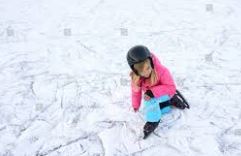A snowy landscape may be the ultimate playground in the eyes of a child, but parents might want to view it more as the ultimate safety challenge.
From deadly snowmobiling accidents to falls through the ice and risk of frostbite, the fun of frolicking in a winter wonderland can quickly turn tragic, even when children are being supervised.
To help make adults more aware of what efforts can make a big difference in preventing such tragedies, there are a number of recommendations for parents.
Perhaps the most basic precaution parents can take is to dress kids warmly enough. That may not always be as easy as it sounds.
You’ve got fluctuations in temperatures and dry or wet conditions, so it’s important to dress children as best you can to prepare for those possibilities.
The best bet for that is dressing them in layers underneath water-repellent coats. Then at least they are warm and dry, and can peel off clothes as they warm up while playing.
Any clothing that can protect against getting wet in the cold is preferable, but even wool can be of some help when it’s wet.
And keep in mind that what might be warm enough for you may still give your little one the chills.
Children are more susceptible to the cold because they tend to have less insulating fat and very thin skin. That makes it more difficult for them to control their body temperature.
It’s advisable to avoid taking infants outdoors when it is colder than 40 degrees, because infants really can lose body heat quickly.
Because children are smaller, they are prone not only to develop frostbite faster than adults, but also are vulnerable to another condition called frostnip.
Before frostbite sets in, frostnip will show up, causing the ears, nose, cheeks, fingers and toes to become white and numb. When a persistent burning sensation occurs, the frostnip is probably developing into frostbite.
If either of the two develop, children should be brought indoors and told to wiggle the part of the body that’s affected in order to increase blood supply.
While you want to warm up the affected areas, be careful not to expose them to high heat, such as a hair dryer or hot fireplace, because frozen tissue is fragile and can be easily damaged. And if blisters appear from frostbite, don’t try to pop them because of risk of infection.
Even if kids are warm enough, many winter sporting activities they might love have built-in hazards.
Following recommendations:
- Make sure the terrain is free of obstacles and far from traffic. Children should sled on packed snow that is free of debris. Check carefully for such snow-covered hazards as rocks, tree limbs and stumps that could endanger sledders or skiers.
- Use equipment that is sturdy and safely built. Avoid equipment with sharp and jagged edges.
- Look for energy-absorbing pads on sled seats.
- Make sure handholds on sleds are secure.
- Be sure sleds and toboggans have easy steering, non-jamming devices.
Parents should also remind children to:
- Sled only on terrain that is free of obstacles.
- Make sure the bottom of the slope is far from streets and traffic.
- Always use a sled with a steering mechanism. Avoid makeshift sleds.
- Avoid lying flat on the sled while riding down hill. Always sit up with feet forward. Lying flat increases the chance of head and abdominal injuries.
- Never ride in a sled that is being pulled by a motorized vehicle.
- Make sure the number of children riding on the sled do not exceed the manufacturer’s recommendations.
And for all outdoor sports, experts recommend the following safety tips:
- Set reasonable time limits on outdoor play. Call children in periodically to warm up with drinks such as hot chocolate.
- Dress children warmly. Several thin layers will help keep children dry, as well as warm. Clothing should consist of thermal long johns, turtlenecks, one or two shirts, pants, sweater, coat, warm socks, boots, gloves or mittens, and a hat.
- And never let children go skating, sledding or skiing alone. Young children should always be supervised by adults.
By Dr. Pnak Chokraborty